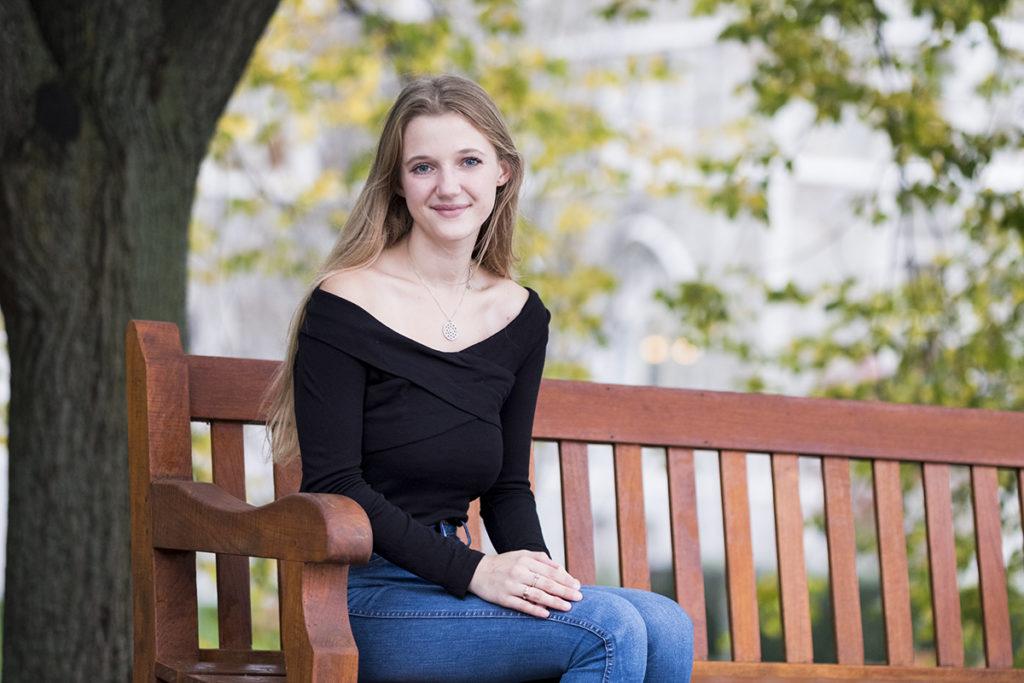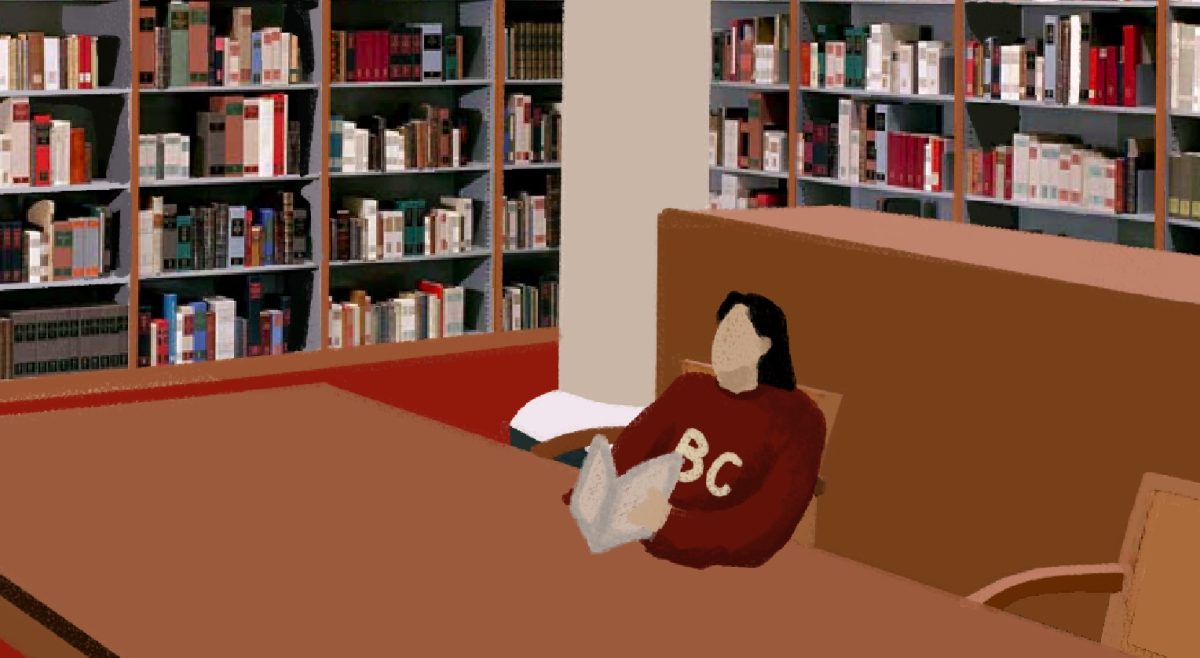Many of us wait years before having that “aha moment,” the instant we have the doubtless realization of what we are meant to do with our lives. But for Ali Malarczyk, MCAS ’19, it unexpectedly came much earlier. When she was just 10 years old, her dad was taken to the hospital because of a heart attack.
Devoted to every step of her dad’s recovery, Malarczyk was by his side day in and day out. She remembers the environment clearly. But instead of fearing the endless gurneys, EKG machines, and blood, she felt intrigued. Every moment within the white walls represented endless possibilities and adventure, and she felt a strong sense of wonderment at the hospital’s capacity for healing, and, in extreme cases like her father’s, saving lives.
In middle school, she cultivated this interest with numerous science classes including anatomy and biology, equipped with the firm conviction that she would continue her foray into medicine in college.
Malarczyk spent her freshman year at Simmons College, a small school just outside Fenway with a total undergraduate enrollment of about 1,800. Through her chemistry courses, she grew close with a professor who recommended her for an open research assistant position at Harvard Medical School.
Although she hadn’t been looking for the job, her desire to branch out and gain more exposure to neurobiology at a hands-on level convinced her to take the interview. Walking into the Armenise Building, she was shocked to find that the quintessential science lab she had been picturing actually consisted of two sections: an expansive laboratory as well as a back room filled with advanced microscopes she had no idea existed.
She remembers finishing her tour of the renowned Armenise Research Building before being interviewed by Postdoc. Brendan Lehnert, and then getting the job.
“Ali interviewed in the fall of her freshman year and struck us as confident and collected during her interview,” Lehnert said in an email. “After we hired her, I taught her a challenging technique, which she was quickly able to improve, such that she is now the lab expert.”
Harvard was just down the road from Simmons and had the opportunities she craved. It was the ideal place for her, and she’s been there ever since. Though her school’s location to her new job provided a great benefit, Malarczyk knew she wanted to attend a bigger university with a diverse student body after her first year. The thriving student life was immediately apparent when she stepped onto Boston College’s campus. She knew it was the place for her.
Malarczyk largely credits BC for furthering her passion for biology and increasing her engagement within the field of medicine. The diverse curriculum for the sciences at BC allows her to mold her education to herself and her passions, and the professors constantly expose her to the many possibilities she has as a biology major—she even remembers an enriching talk at BC that emphasized medicine while simultaneously incorporating history into the lecture. She also loves to take advantage of the opportunities BC offers its students: Malarczyk is a regular attendee of office hours, and even if she doesn’t need help grasping the material, she loves going just to talk with her professors and engage with the material. She appreciates BC’s professors for their willingness to connect with students and have individualized, intellectual conversations.
Her professors feel the same way about her.
“She represents all of the things that have impressed me about BC students not only on the intellectual and academic side, but also on the personal side,” Karen Atkinson, Malarczyk’s summer organic chemistry teacher, said in an email. “She is kind, honest, and thoughtful, even in the pressure cooker of an intensive course.”
After a long morning of classes, most of us can be found heading back to our dorms for a nap, grabbing lunch at Eagle’s with friends, or heading to O’Neill to get a jump on the next day’s work. But if you’re Malarczyk, you ride the Commonwealth Ave. bus down to the Reservoir T stop, maybe getting a head start on some impending reading on the way, hop off at Longwood, and from there it’s a 20-minute walk to the renowned Harvard Medical School, where you’ll stay for the next seven to eight hours.
The Armenise Medical Research Building is one of the classically beautiful buildings that surrounds the quadrangle of Harvard Medical School. Malarczyk finishes her long walk to Harvard at this spot, then makes a beeline for the Ginty Lab, a research lab focusing on “the function, organization, and mechanisms of assembly of the peripheral nervous system and spinal cord circuits that underlie the sense of touch.”
Malarczyk passes through the “typical” part of the lab, walking by the black countertops and the chemicals lined up neatly on shelves—everything is in its proper place. She then makes her way down to the basement, where her revolutionary research takes place: the mouse room. The “mouse room” is a bit like a highly fortified bank vault. After washing her hands and adorning herself from head to toe in scrubs, gloves, shoe covers, and more, she types in several PIN numbers and codes and makes her way through a series of underground tunnels before she finally reaches the room, in which there are wall-to-wall cages filled with mice—long biological lines of mice whose ancestors date back years.
“You have to fully wash yourself,” Malarczyk said. “Your entire experiment could be completely destroyed if you had accidentally touched one with a contaminant.”
Malarczyk is also not your run-of-the-mill research assistant. She is at the frontline of this groundbreaking research. After pulling on a crisp white lab jacket, she consults her checklists and makes sure all the materials are properly stocked, and then she’s ready to go.
Specifically, Malarczyk works under Lehnert, who studies the relationship between neurons and the skin. To do so, he self-generates rare viruses and injects them into the mice to study their propagation throughout the brains of the mice.
The physical barrier completely shuts out the outside world, and as soon as she enters the mouse room, Malarczyk is ready to start working. After playing with the mice for an hour, Malarczyk gets to work on her main responsibility: extracting their DNA. She takes a small sample of skin or hair, puts it in a solution, and then puts them on gels and runs it through a process called electrophoresis, which is a technique that allows her to analyze the DNA.
She is also thoroughly involved in the surgical aspects of the experiments. Once the mouse dies, Malarczyk dissects out the spinal cord, brain, and brainstem. She uses a machine to physically slice the brain, which can be cut into 150 individual slices, and the brainstem, which can be cut into 80. After tagging where the virus has spread, she maps the brain and can see exactly how far the virus propagated. Each cycle of the experiment generally takes about 24 to 48 hours, and the viruses grow and are genetically modified at different times, so there is a cyclical feeling to her research, which she participates in almost every day.
The reason behind these experiments is to tag the neurons in the body that are affected by the spread of the specific disease Lehnert has generated. Malarczyk’s currently learning how to suture and inject the viruses, something that many research assistants have been unqualified to do.
By looking at the propagation of these viruses and how they fluorescently lit up different neurons in the brain when touched with a mechanical stimulus, Malarczyk was integral in the discovery that there is a disproportionate relationship between where projections occur in the brain with what neurons are stimulated.
Even with her tight schedule, Malarczyk remains involved in BC’s campus life. She currently serves as an RA in the always lively Walsh Hall, which has a surprising correlation to her medical career. Her graduate resident director, Jaimie Carvalho, notes that as an RA, Malarczyk is learning how to listen to people, show compassion for others, and have a positive demeanor—all essential skills for her promising future in medicine.
“I think her superb initiative is really inspiring,” Carvalho said. “She doesn’t just do what she needs to do to check off boxes, she does them really well.”
After graduating from BC, Malarczyk wants to continue exploring the field of medicine and hopefully find some clarity on whether or not she wants to be a cardiologist or a neurobiologist. To do this, she wants to go to medical school, but she also wants to keep up her participation in research. Ultimately, she hopes to receive her doctorate and become a licensed M.D. She surmises that her research may just be the push she needs to decide on neurobiology.
“Don’t get me wrong, I find myself thinking about [my research] a lot,” Malarczyk said. “Every day I’m thinking about how I can further do this experiment.”
In the future, this groundbreaking research could even help find a cure for muscular dystrophies and paralysis as it examines the neuron proportionate relationship to sensation in the skin. For something that seems so small when the research involves tiny mice, it could eventually become part of a big scientific paper.
As for why she’s been so successful in her research opportunities, Malarczyk credits her passion for biology and medicine as well as her tenacity more than anything else.
“Do what you love,” she said. “Just take a risk and try something. It’s very easy to quit, but don’t be afraid of risks. I was never afraid of risks, and I’m here now.”
Featured Image by Sam Zhai / Heights Staff













